Day 1 of a three day Easter weekend tour today. It was a glorious, bright, sunny day with wall to wall blue skies. It was hot out of the wind, but a very light NE breeze kept temperatures more comfortable on the coast. Great birding weather! We spent the day exploring the centre of the North Norfolk coast.
Burnham Overy Dunes was our destination for the morning. As we walked down the track across the fields we could hear the rattling song of a Lesser Whitethroat in the blackthorn. It was typically skulking, but we saw it as it flew out and landed in the bushes the other side. A pair of Bullfinches flew along ahead of us, perching low down on the edge of the path, the bright pink male glowing in the sunshine. A Willow Warbler sang briefly, but then flew past us and seemed to move quickly inland.
Looking up, we noticed two Barnacle Geese flying in across the track. They landed out on the grazing meadows with a large flock of grey geese. The Barnacles were most likely feral birds, which breed in Holkham Park, but the grey geese were Pink-footed Geese, about 100 of them. Most of the wintering birds left back in February to stage further north, but these had stayed on and would soon need to be leaving on the journey back to Iceland for the breeding season. There were a couple of Greylags with them, giving us a nice comparison between the two species, and two Egyptian Geese as well.

There were surprisingly few hirundines moving today, probably due to the NE wind. But a Swallow did fly over as we were walking out, closely followed by a Sand Martin.
Out over the grazing marshes, a Sedge Warbler was singing from the briars beside the track. We stopped to watch it and heard a Grasshopper Warbler reeling a bit further up. It was skulking in some brambles but we positioned ourselves to see it and after a minute or so it appeared in the top, typically just as two people were walking past. It promptly dropped straight back in! After a while, the Grasshopper Warbler appeared again and this time we could get it in the scope.
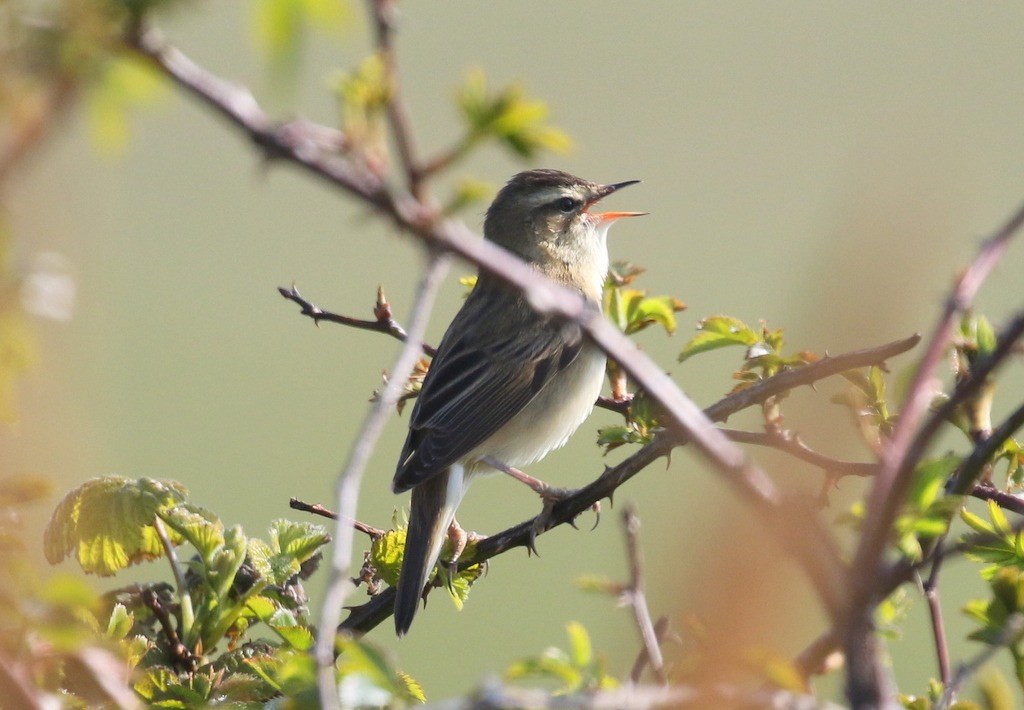
Our first Spoonbill of the morning had already flown past distantly, heading out towards the harbour. Then, while we were listening to the Grasshopper Warbler, another Spoonbill appeared right next to us, feeding in a small pool. We watched it with its head down, sweeping its bill from side to side through the water, occasionally throwing its head back to swallow something. It seemed to be catching a lot! It was an adult – we could see its yellow-tipped black bill – and in breeding condition, with a bushy nuchal crest, bright red fringed yellow skin under the bill and a mustard wash across its breast.
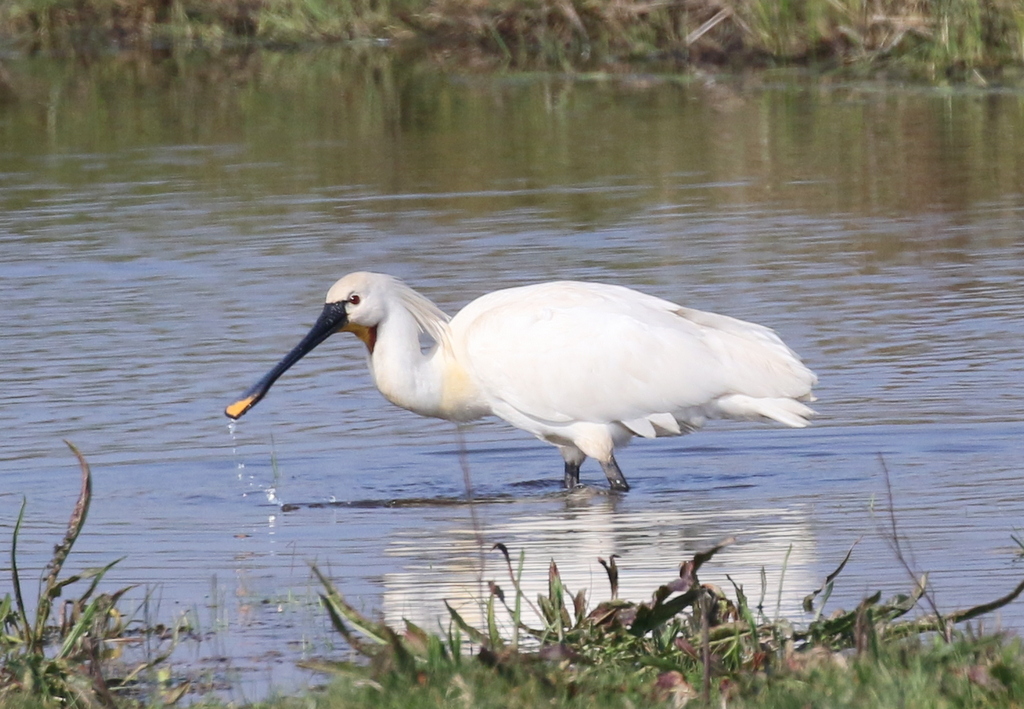
There were more Sedge Warblers singing further down the track, they had clearly arrived in good numbers now. At the junction with the seawall, another Willow Warbler was singing. This one we could see, flitting around in the top of some low brambles. This is not a likely territory for a Willow Warbler, so the two we had seen on the walk out were probably migrants, fresh in, just stopping here to feed on their way to their breeding sites.
Up on the seawall, the tide was in and the harbour channel was full of water. Several waders were roosting out on the islands of saltmarsh, Avocets, Redshanks and Black-tailed Godwits. Some of the godwits are getting very rusty now on their heads and breasts as they moult into breeding plumage, and we stopped to look at one dark chestnut bird which was clearly of the Icelandic race.
Looking out over the grazing marshes from here, there were still a few pools out in the grass, although they are starting to dry out steadily now. There were a few ducks dozing around the margins, mainly Teal and a few Wigeon, still lingering winter visitors. A large flock of Brent Geese flew over from the harbour and landed on the saltmarsh – it won’t be long now before they are leaving on their way back to Siberia for the breeding season.
There were two Wheatears out on the saltmarsh too, but they were very distant and disappeared into the vegetation. They were a little like buses today, and once we got out into the dunes, there were a lot more Wheatears feeding on the short grass. There were two more just past the boardwalk bushes and as we started to walk east, we counted at least eight together on the first slope. The males were rather deep burnt orange on the breast, suggesting they were birds of the Greenland race.
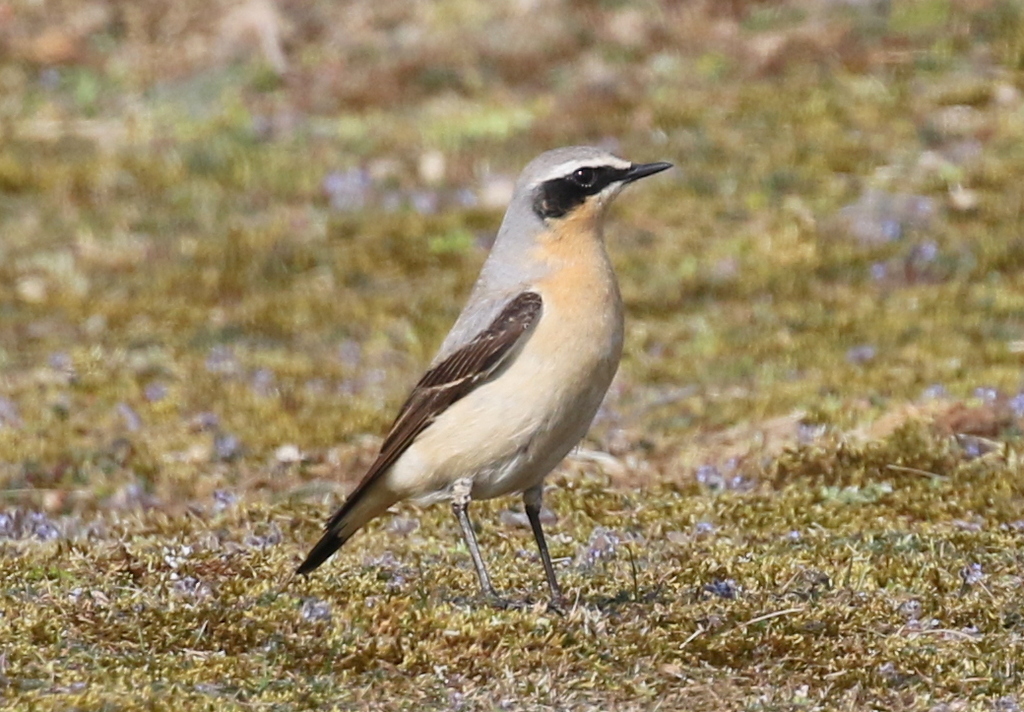
Over the ridge, there were yet more Wheatears. But as we stopped to scan the dunes ahead, we noticed two Ring Ouzels on the opposite slope. We got them in the scope and could see their bright white gorgets, two males. They flew lower down, out of view, so we walked round for a closer look.
We positioned ourselves where we could watch the Ring Ouzels feeding quietly and thankfully we had already enjoyed a good long look before two cyclists appeared at the top of the dunes. The Ring Ouzels were nervous and one flew up into the top of a nearby bush. The cyclists presumably saw us, because they stopped, but then came over the top and flushed the Ring Ouzels, which flew away east over the dunes. We watched the cyclists riding their bikes off in that direction too.
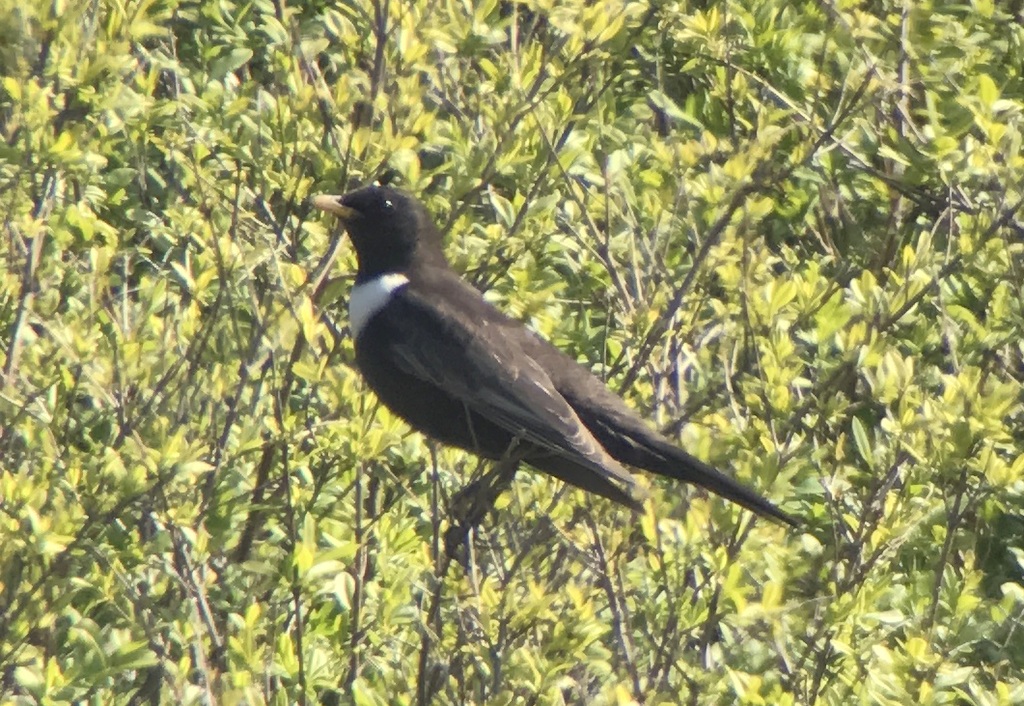
Carrying on through the dunes ourselves, in the same direction, we could see the Ring Ouzels flying off again ahead of us. We also flushed several Song Thrushes from the bushes as we passed, migrants stopping off to feed in the dunes before heading back over the sea to the continent. There were yet more Wheatears along here too.
We had heard a Cuckoo calling on and off as we walked out. Now we spotted it flying past, over the bushes just beyond the fence to the south of us. It was being pursued relentlessly by a Meadow Pipit. The Cuckoo tried to land, but realised it wouldn’t get any peace, so headed off west, the pipit following it all the way. Meadow Pipit is a favoured host for the Cuckoos here!
A Siberian Chiffchaff had been reported in the bushes just before the pines, so we made our way over to see if we could see it. But the only chiffchaffs we could find were Common Chiffchaffs. There were a couple of Blackcaps singing here and, as we looped round through the pines to the start of the track, we could hear a Goldcrest singing. As we stopped by the gate and had a quick look out over the grazing marshes, we could see a couple of Coal Tits, two Long-tailed Tits and the Goldcrests on the sunny edge of the pines.
Walking back through the dunes, we looked across the grazing marshes and spotted a Bittern distantly in flight. We watched as it flew across and dropped down into the reeds over by the seawall. Presumably the same Ring Ouzels were back again where we had seen them earlier, but there were at least three now. We could see a pair, the female with a duller brown-tinged gorget and a separate male. Back at the boardwalk bushes, a Blackcap was flycatching from the apple tree but there was no sign of the Firecrest reported earlier.
Back along the seawall, we could hear a Bittern booming out in the reedbed, presumably the bird we had seen fly in earlier. It was well hidden down in the reeds now though. We could hear Bearded Tits calling on and off, but despite scanning the edges of the pools, we couldn’t see them. They were keeping well tucked down in the reeds too.
Along the track, the butterflies were more active now it had warmed up. We saw several Holly Blue and Speckled Wood fluttering around the Alexanders in the verges. A Common Whitethroat was singing from the hedge by the road back at the van and with a bit of patience it eventually appeared in the top.
We headed down to Holkham briefly to use the facilities. It was very busy here and there were so many cars parked on Lady Anne’s Drive it was full, despite the fact that they had a field open as an overflow car park. They were turning people away! A few House Martins and Swallows whirled around the houses in the village.
We made our way back to Burnham Norton for lunch, passing a small group of Red Deer out in one of the fields by the Park on the way. We sat on the grass in the sunshine and enjoyed the view, looking out over the marshes. A Grey Heron flew in and landed in the ditch in front of us, where it stood motionless, fishing. A Mistle Thrush was feeding out on the grass beyond.
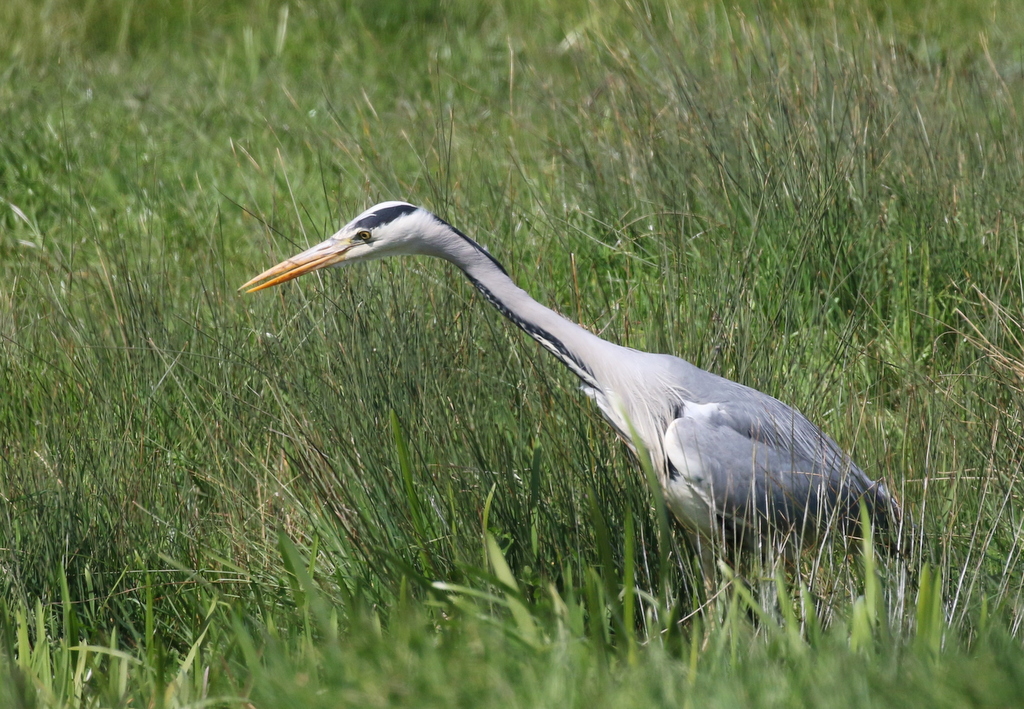
After lunch, as we put our bags back in the van, a Sparrowhawk circled over the car park. We could see a Red Kite circling over the marshes to the east and as we walked out along the bank a second Red Kite flew past and joined it. There were several Common Buzzards up too now, circling in the warm air. A smart grey male Marsh Harrier drifted over the path in front of us.
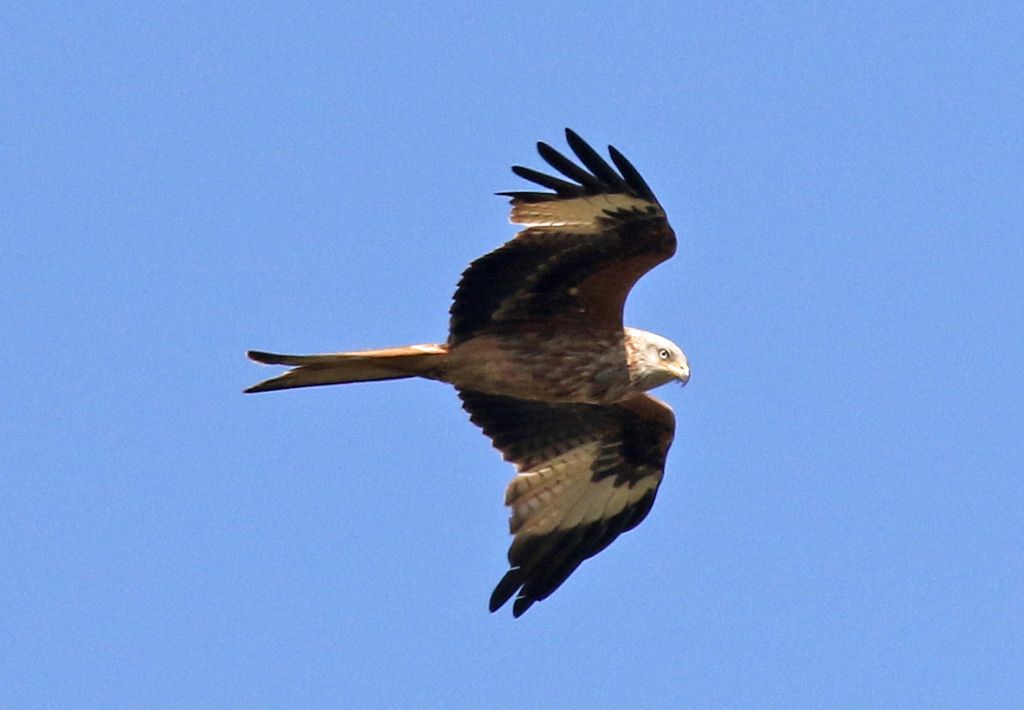
There were a few Pied Wagtails feeding around the dried up pools out on the grazing marsh, and we noticed a much paler one in with them, a White Wagtail, the continental cousin of our Pieds and a migrant passing through here. While we were watching the White Wagtail, one of the group spotted a Whimbrel feeding on the grass further back. It was noticeably small and dark, slim and short-billed, particularly compared with the bigger, greyer Curlew nearby.
From out on the seawall, we spotted a group of Yellow Wagtails which flew up from around the cows out in the middle. They circled round and landed by some more cows but, typically they were half hidden now behind a bramble hedge and the ground sloped away just beyond where the cows were standing. We could just see one or two of the Yellow Wagtails around the cows’ feet from time to time. Two more Whimbrels were also out in the short grass here, along with three Wheatears.
A Cuckoo flew in and landed in the bushes just below the seawall ahead of us. We could see it picking at a web on a stem in front of it, eating caterpillars, most likely of the Brown-tail moth. We were watching it in the scope but could see a woman walking towards us along the seawall. The Cuckoo took off, but then flew right past giving us a great view and landed on a bush behind us.
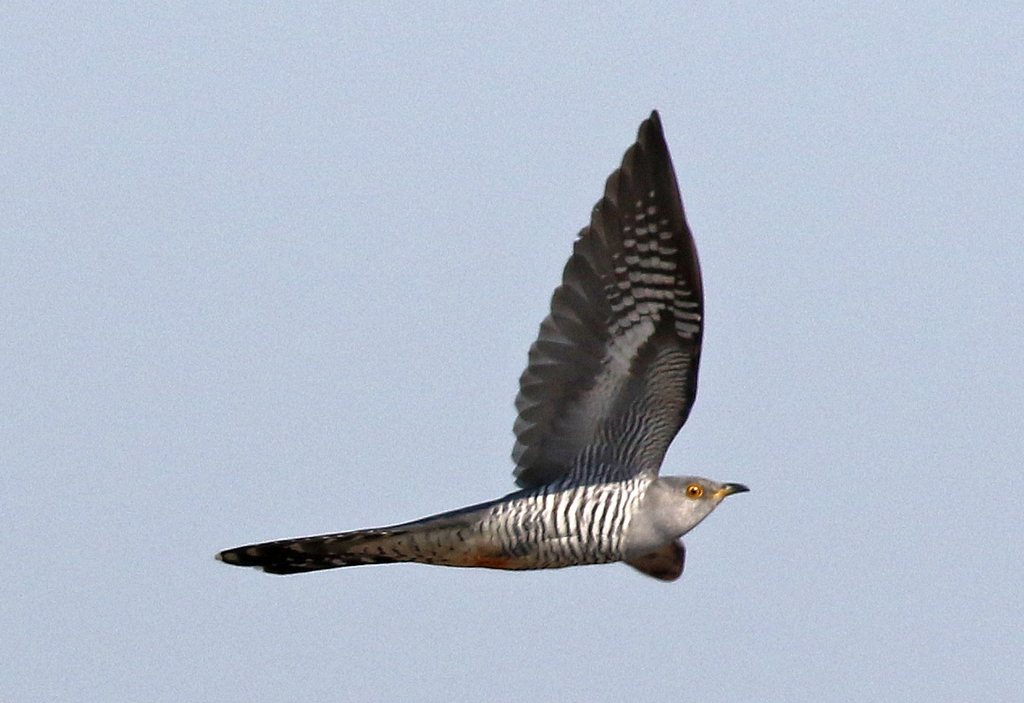
We stopped to look out across the harbour channel, and could see lots of gulls on the sandbanks down among the boats over towards Burnham Overy Staithe. A pair of Lesser Black-backed Gulls were in with the Black-headed Gulls. The pools on the corner of the seawall are looking really good for waders at the moment. We had a quick look hoping for perhaps a migrant sandpiper, but all we could find today were Black-tailed Godwits and Redshanks.
We took the path which cuts back across the middle of the grazing marsh. It was still a bit wet in places, but just about passable. The Yellow Wagtails were flying round and one landed briefly in the top of a bare bush. Some of the cows were lying down, so the Yellow Wagtails flew over and settled again around the feet of some other that were feeding in the middle, unfortunately they chose the cows which were just behind a line of low reeds from us.
A Reed Warbler was singing quietly, but stopped before we could get closer to it. So we walked over to where it had been and stopped to listen while we watched to see if the wagtails would show themselves. A Chinese Water Deer was feeding on the back of the field the other side of the path.
There was a nice selectin of ducks in the channel which crossed the marshes in front of us. A pair of Shoveler, a few Tufted Ducks and a pair of Common Pochard. A female Wheatear flew in and landed on the top of a bush right in front of us. A Cetti’s Warbler shouted from the ditch just behind us but we still couldn’t see it.
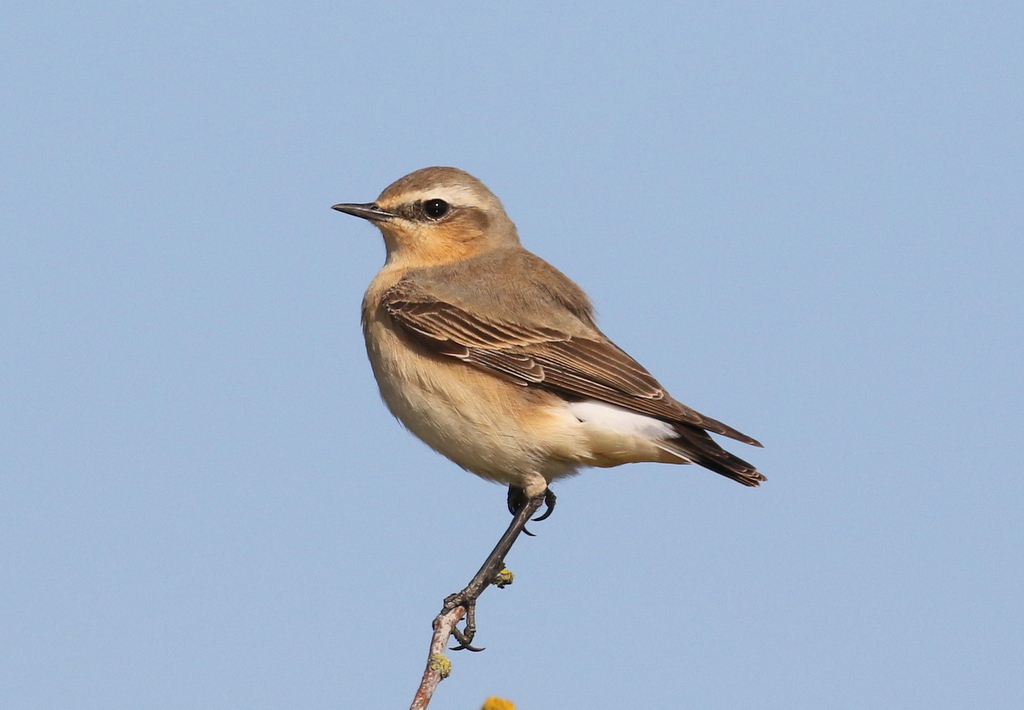
Some of the cows walked over to graze just across the ditch from where we were standing, and the ones which had been behind the reeds came back round into the field our side. We had hoped the Yellow Wagtails might fly over to the closer cows but even though more and more cows came over to our side of the field, the wagtails remained stubbornly out in the middle, even when there were just two cows left there. At least we could see the Yellow Wagtails now – at least eight of them. We had hoped there might be one of the continental subspecies with them, but we could not see they were all of the British race, flavissima.
It was lovely to stand and look out over the marshes in the afternoon sunshine, but it was time to call it a day now. Still, we had another day to look forward to tomorrow.
















